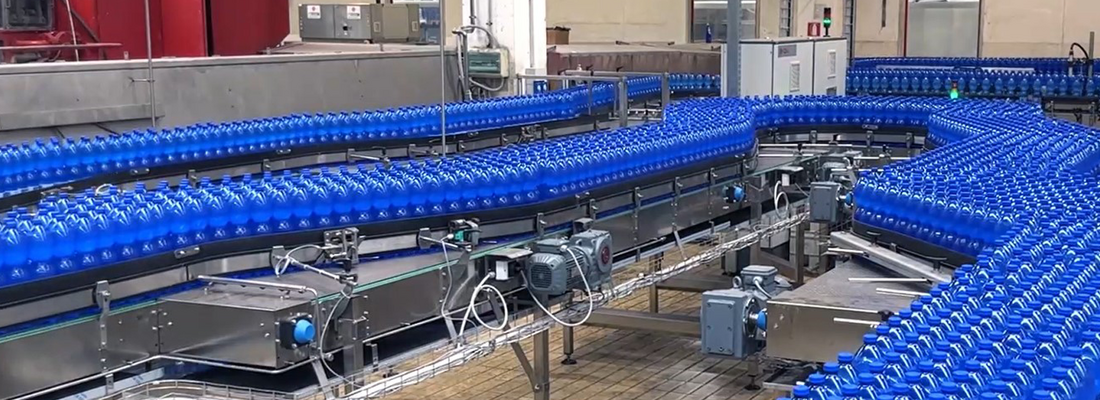Automation and Smart Conveyors
One of the most significant trends in bottling conveyor technology is the integration of automation and smart systems. As production lines become more complex and demand increases, automation has become essential to maintaining efficiency and reducing human intervention.
Smart conveyors equipped with advanced sensors are now capable of real-time monitoring of various parameters, such as bottle positioning, speed, and flow rates. These sensors can detect any irregularities or potential issues, such as bottle jams or deviations in the production line, and automatically adjust the system to correct the problem. This reduces downtime and increases overall efficiency.
Additionally, smart conveyors can communicate with other machines on the production line, creating a fully integrated and automated system. This interconnectivity allows for more precise control over the entire bottling process, leading to higher productivity and reduced waste.
Another aspect of automation is predictive maintenance. By utilizing data collected from sensors and monitoring systems, bottling conveyors can predict when maintenance is required before a breakdown occurs. This proactive approach helps reduce unplanned downtime and extends the lifespan of the equipment.
Predictive maintenance systems analyze data to identify patterns and predict when components, such as motors or belts, might fail. This allows maintenance teams to schedule repairs during planned downtime, ensuring minimal disruption to production.
Modular Conveyor Systems
Flexibility and scalability are critical for bottling companies that need to adapt to changing production demands. Modular conveyor systems have emerged as a popular trend in the industry, offering a customizable and scalable solution for bottling lines.
One of the key advantages of modular conveyors is their ability to be customized for different types of bottles. Whether a company is bottling water, soda, or spirits, modular conveyors can be easily reconfigured to handle different bottle sizes and shapes. This versatility is particularly valuable for companies that produce a wide range of products or frequently introduce new ones.
Modular systems also allow for the easy addition or removal of conveyor sections, enabling bottling companies to scale their operations as needed. Whether expanding production capacity or adapting to new packaging formats, modular conveyors provide the flexibility required to meet evolving business needs.
Modular conveyor systems are designed for quick installation and easy maintenance. Since the systems are built using interchangeable modules, damaged or worn-out sections can be replaced quickly without the need for extensive downtime. This modularity simplifies the maintenance process and reduces the time and cost associated with repairs.
Additionally, because the system can be easily reconfigured, bottling companies can make changes to their production lines with minimal disruption. This adaptability is especially important in a fast-paced industry where production demands can change rapidly.
Energy Efficiency and Sustainability
As sustainability becomes a priority for businesses worldwide, the bottling industry is no exception. Energy efficiency and sustainability are now major trends in conveyor technology, as companies seek to reduce their carbon footprint and operating costs.
New developments in conveyor motors and drives are helping to improve energy efficiency in bottling operations. High-efficiency motors, such as permanent magnet motors and variable frequency drives (VFDs), consume less energy while delivering the same or better performance compared to traditional motors.
Variable frequency drives allow for precise control of conveyor speed, reducing energy consumption during periods of low production or idle times. This can result in significant energy savings over time, making the entire production process more environmentally friendly and cost-effective.
Another trend in bottling conveyor technology is the use of recycled and sustainable materials in conveyor construction. Conveyor belts made from recycled plastics or biodegradable materials are gaining popularity as companies strive to reduce their environmental impact.
In addition to using sustainable materials, many manufacturers are designing conveyors with longer lifespans and reduced maintenance requirements, further minimizing waste and resource consumption. By investing in more durable and eco-friendly conveyor systems, bottling companies can align their operations with sustainability goals and reduce their overall environmental footprint.
Hygienic Conveyor Design
Maintaining high levels of hygiene is critical in the bottling industry, particularly for companies producing beverages like water, juice, and dairy products. Hygienic conveyor design has become a top priority as companies seek to ensure product safety and comply with stringent food and beverage regulations.
One of the main trends in hygienic conveyor design is the development of easy-to-clean systems. These conveyors are constructed with minimal crevices and smooth surfaces to prevent the buildup of debris, bacteria, or other contaminants. Materials such as stainless steel are commonly used due to their resistance to corrosion and ease of cleaning.
Quick-release components, such as belts and rollers, are also being incorporated into conveyor designs to facilitate faster and more thorough cleaning. This reduces the time needed for sanitation procedures, allowing companies to maintain high hygiene standards without compromising productivity.
Hygienic conveyors are designed to meet or exceed food safety regulations, such as those set by the Food and Drug Administration (FDA) and the European Food Safety Authority (EFSA). These regulations often require that conveyors used in food and beverage production are made from materials that are safe for contact with consumable products and can be easily sanitized.





